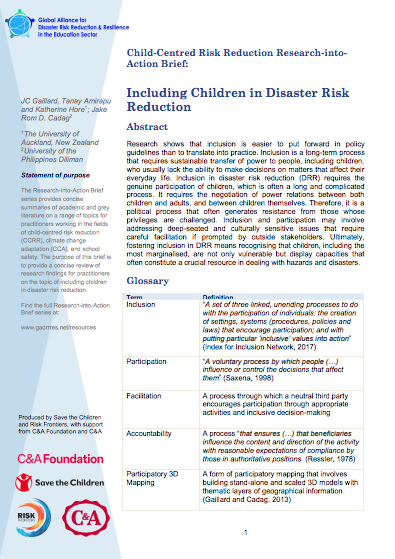
Research-into-Action Brief: Including Children in Disaster Risk Reduction
Publication year:
2018
English, Spanish,Hindi
Format:
pdf (864.4 KiB)
Publisher:
GADRRRES, Global Alliance for Disaster Risk Reduction and Resilience in the Education Sector
Research shows that inclusion is easier to put forward in policy guidelines than to translate into practice. This brief explores how inclusion is a long-term process that requires sustainable transfer of power to people, including children, who usually lack the ability to make decisions on matters that affect their everyday life. Inclusion in disaster risk reduction requires the genuine participation of children, which is often a long and complicated process. It requires the negotiation of power relations between both children and adults, and between children themselves. Therefore, it is a political process that often generates resistance from those whose privileges are challenged. Inclusion and participation may involve addressing deep-seated and culturally sensitive issues that require careful facilitation if prompted by outside stakeholders. Ultimately, fostering inclusion in disaster risk reduction means recognising that children, including the most marginalised, are not only vulnerable but display capacities that often constitute a crucial resource in dealing with hazards and disasters. This brief is part of a series.
The Research-into-Action Brief series includes two main tools:
1. Research-into-Action Briefs and Summaries
2. Shared Bibliography on Zotero: https://www.zotero.org/groups/1857446/ccrr__css
These tools are for practitioners working in fields of child-centred risk reduction (CCRR), climate change adaptation (CCA) and school safety. The briefs and summaries are also intended to be used for training and capacity development for practitioners and partners, including government.
The briefs provide a concise review of research findings on a range of topics which have been selected by practitioners. The briefs have a focus on how the research findings could be (or have been) applied in practice. Each brief is 6-10 pages long, and generally contains a glossary, literature review, case study or examples, practical applications, key readings, and follow-up questions.
The summaries are two pages long and provide a quick snapshot of the main messages from the briefs. These can be used to both promote the full Research-into-Action Brief, to provide a quick overview of the topic, or to promote the use of research.
Read full abstract
Authors
View & Download
Autodetected language
English
3 Documents
Other languages
Spanish
1 Documents
Document information
Publisher
Format
Rights
© Author/Publisher
Found a mistake? Help us improve!
If you have noticed a document assigned to the wrong author or any other inaccuracies, let us know! Your feedback helps us keep our data accurate and useful for everyone.
Share
Link
